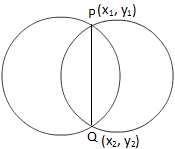Subscribe to our ▶️ YouTube channel 🔴 for the latest videos, updates, and tips.
Equation of the Common Chord of Two Circles
We will learn how to find the equation of the common chord of two circles.
Let us assume that the equations of the two given intersecting circles be x\(^{2}\) + y\(^{2}\) + 2g\(_{1}\)x + 2f\(_{1}\)y + c\(_{1}\) = 0 ……………..(i) and x\(^{2}\) + y\(^{2}\) + 2g\(_{2}\)x + 2f\(_{2}\)y + c\(_{2}\) = 0 ……………..(ii), intersect at P (x\(_{1}\), y\(_{1}\)) and Q (x\(_{2}\), y\(_{2}\)).
Now we need to find the equation of the common chord PQ of the given circles.
Now we observe from the above figure that the point P (x\(_{1}\), y\(_{1}\)) lies on both the given equations.
Therefore, we get,
x\(_{1}\)\(^{2}\) + y\(_{1}\)\(^{2}\) + 2g\(_{1}\)x\(_{1}\) + 2f\(_{1}\)y\(_{1}\) + c\(_{1}\) = 0 ……………..(iii)
x\(_{1}\)\(^{2}\) + y\(_{1}\)\(^{2}\) + 2g\(_{2}\)x\(_{1}\) + 2f\(_{2}\)y\(_{1}\) + c\(_{2}\) = 0 ……………..(iv)
Now subtracting the equation (4) from equation (3) we get,
2(g\(_{1}\) - g\(_{2}\))x\(_{1}\) + 2 (f\(_{1}\) - f\(_{2}\))y\(_{1}\) + C\(_{1}\) - C\(_{2}\) = 0 ……………..(v)
Again, we observe from the above figure that the point Q (x2, y2) lies on both the given equations. Therefore, we get,
x\(_{2}\)\(^{2}\) + y\(_{2}\)\(^{2}\) + 2g\(_{1}\)x\(_{2}\) + 2f\(_{1}\)y\(_{2}\) + c\(_{1}\) = 0 ……………..(vi)
x\(_{2}\)\(^{2}\) + y\(_{2}\)\(^{2}\) + 2g\(_{2}\)x\(_{2}\) + 2f\(_{2}\)y\(_{2}\) + c\(_{2}\) = 0 ……………..(vii)
Now subtracting the equation (b) from equation (a) we get,
2(g\(_{1}\) - g\(_{2}\))x\(_{2}\) + 2 (f\(_{1}\) - f\(_{2}\))y\(_{2}\) + C\(_{1}\) - C\(_{2}\) = 0 ……………..(viii)
From conditions (v) and (viii) it is evident that the points P (x\(_{1}\), y\(_{1}\)) and Q (x\(_{2}\), y\(_{2}\)) lie on 2(g\(_{1}\) - g\(_{2}\))x + 2 (f\(_{1}\) - f\(_{2}\))y + C\(_{1}\) - C\(_{2}\) = 0, which is a linear equation in x and y.
It represents the equation of the common chord PQ of the given two intersecting circles.
Note: While finding the equation of the common chord of two given intersecting circles first we need to express each equation to its general form i.e., x\(^{2}\) + y\(^{2}\) + 2gx + 2fy + c = 0 then subtract one equation of the circle from the other equation of the circle.
Solve example to find the equation of the common chord of two given circles:
1. Determine the equation of the common chord of the two intersecting circles x\(^{2}\) + y\(^{2}\) - 4x - 2y - 31 = 0 and 2x\(^{2}\) + 2y\(^{2}\) - 6x + 8y - 35 = 0 and prove that the common chord is perpendicular to the line joining the centers of the two circles.
Solution:
The given two intersecting circles are
x\(^{2}\) + y\(^{2}\) - 4x - 2y - 31 = 0 ……………..(i) and
2x\(^{2}\) + 2y\(^{2}\) - 6x + 8y - 35 = 0
⇒ x\(^{2}\) + y\(^{2}\) - 3x + 4y - \(\frac{35}{2}\) ……………..(ii)
Now, to find the equation of the common chord of two intersecting circles we will subtract the equation (ii) from the equation (i).
Therefore, the equation of the common chord is
x\(^{2}\) + y\(^{2}\) - 4x - 2y - 31 - (x\(^{2}\) + y\(^{2}\) - 3x + 4y - \(\frac{35}{2}\)) = 0
⇒ - x - 6y - \(\frac{27}{2}\) = 0
⇒ 2x + 12y +
27 = 0, which is the required equation.
The slope of the common chord 2x + 12y + 27 = 0 is (m\(_{1}\)) = -\(\frac{1}{6}\).
Centre of the circle x\(^{2}\) + y\(^{2}\) - 4x - 2y - 31 = 0 is (2, 1).
Centre of the circle 2x\(^{2}\) + 2y\(^{2}\) - 6x + 8y - 35 = 0 is (\(\frac{3}{2}\), -2).
The slope of the line joining the centres of the circles (1) and (2) is (m\(_{2}\)) = \(\frac{-2 - 1}{\frac{3}{2} - 2}\) = 6
Now m\(_{1}\) ∙ m\(_{2}\) = -\(\frac{1}{6}\) ∙ 6 = - 1
Therefore, we see that the slope of the common chord and slope of the line joining the centres of the circles (1) and (2) are negative reciprocals of each other i.e., m\(_{1}\) = -\(\frac{1}{m_{2}}\) i.e., m\(_{1}\) ∙ m\(_{2}\) = -1.
Therefore, the common chord of the given circles is perpendicular to the line joining the centers of the two circles. Proved
● The Circle
- Definition of Circle
- Equation of a Circle
- General Form of the Equation of a Circle
- General Equation of Second Degree Represents a Circle
- Centre of the Circle Coincides with the Origin
- Circle Passes through the Origin
- Circle Touches x-axis
- Circle Touches y-axis
- Circle Touches both x-axis and y-axis
- Centre of the Circle on x-axis
- Centre of the Circle on y-axis
- Circle Passes through the Origin and Centre Lies on x-axis
- Circle Passes through the Origin and Centre Lies on y-axis
- Equation of a Circle when Line Segment Joining Two Given Points is a Diameter
- Equations of Concentric Circles
- Circle Passing Through Three Given Points
- Circle Through the Intersection of Two Circles
- Equation of the Common Chord of Two Circles
- Position of a Point with Respect to a Circle
- Intercepts on the Axes made by a Circle
- Circle Formulae
- Problems on Circle
11 and 12 Grade Math
From Equation of the Common Chord of Two Circles to HOME PAGE
Didn't find what you were looking for? Or want to know more information about Math Only Math. Use this Google Search to find what you need.



New! Comments
Have your say about what you just read! Leave me a comment in the box below. Ask a Question or Answer a Question.